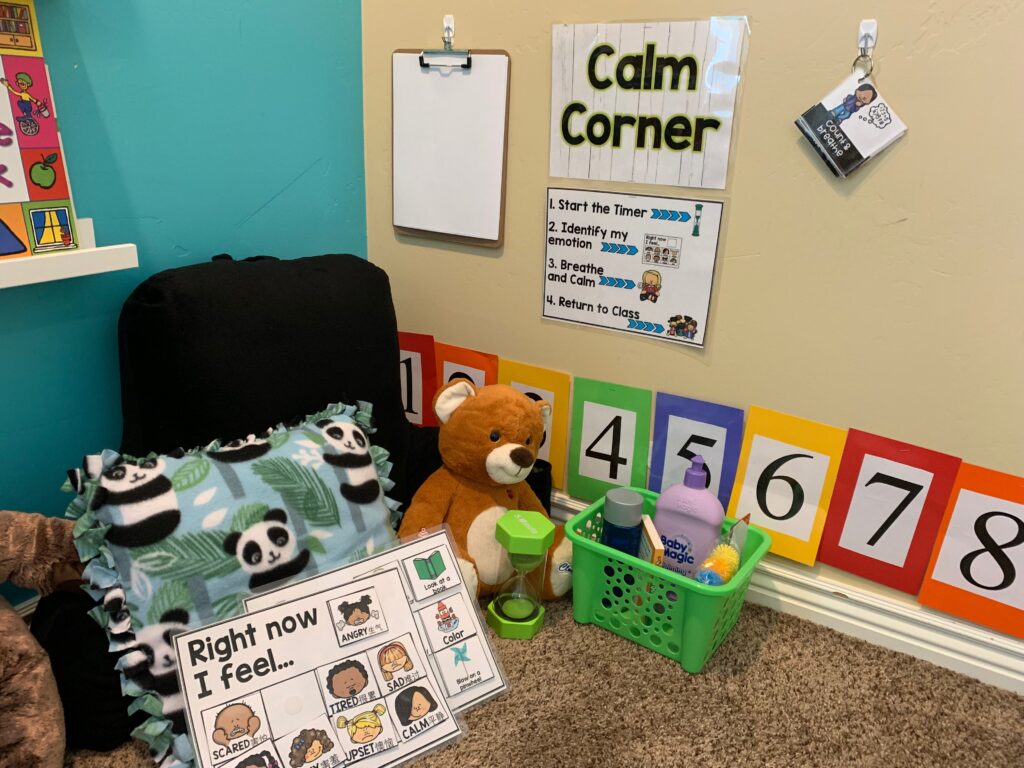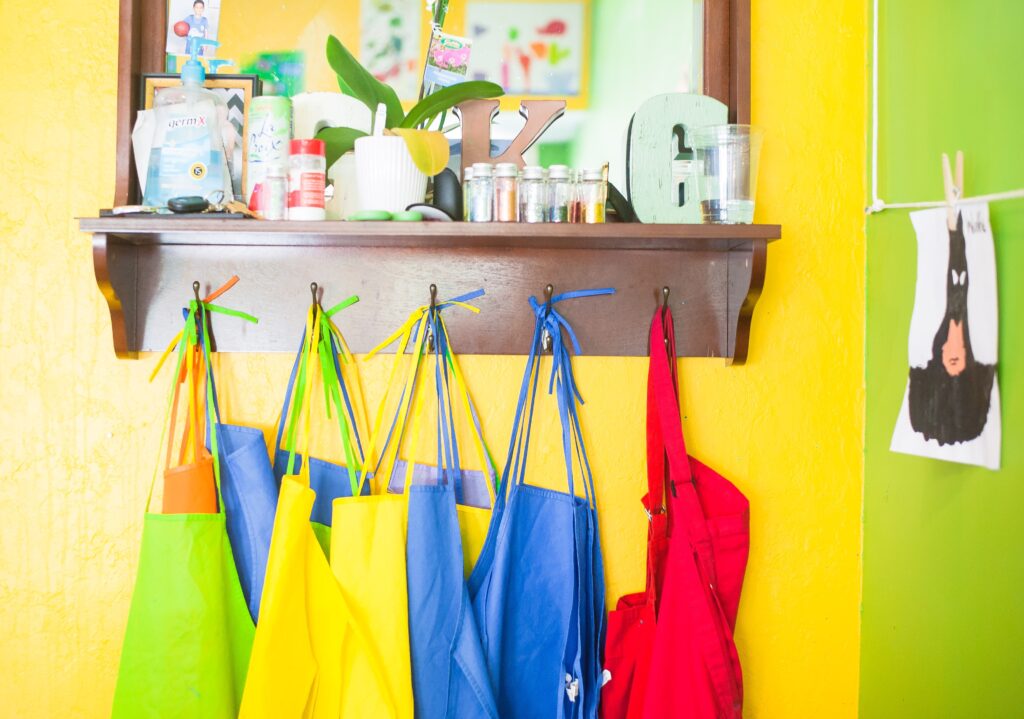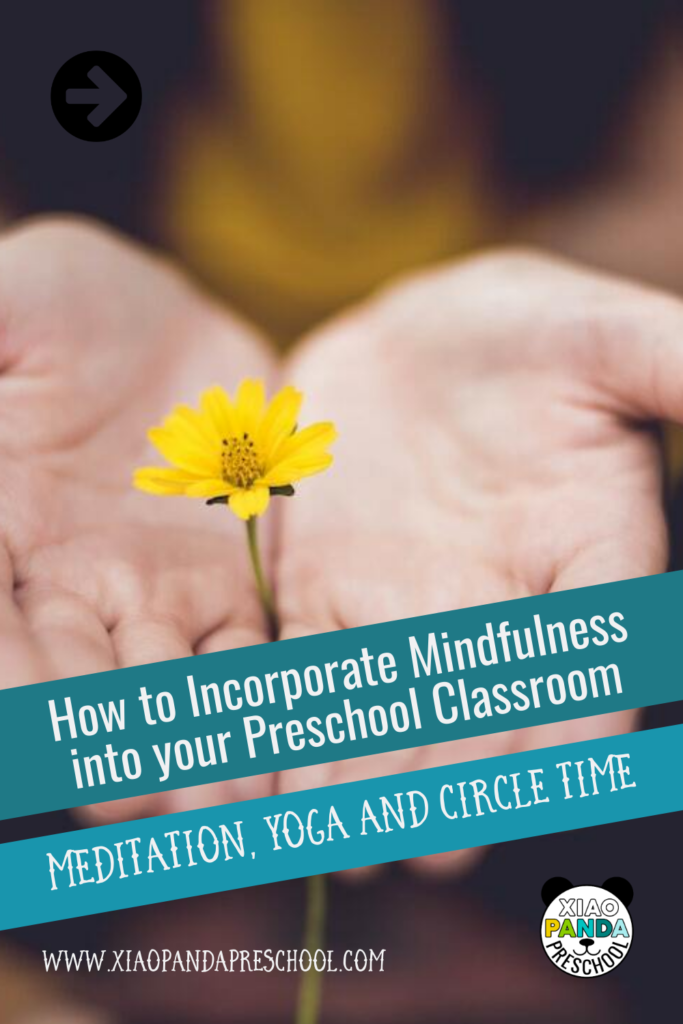Mindfulness is an increasingly popular approach to life that can have tremendous benefits for both children and adults alike. As teachers, it is our responsibility to provide our students with the tools they need to succeed in life, and one of those tools is the practice of mindfulness for kids. Mindfulness can help our young students better manage their emotions, stay focused, and handle stressful situations with grace. In this blog post, we will explore what mindfulness is, why it is so important, and how to implement it into our preschool classrooms. We will also discuss the benefits of mindfulness for kids and how it can improve the learning environment.
I have a full post about create a “Calm Corner” here.

Understanding Mindfulness
Mindfulness is a practice of being present and aware of the current moment, without judgement. It is a way to connect the mind and body, and can help children regulate their emotions and thoughts. Mindfulness activities for kids can be as simple as taking deep breaths or focusing on their senses.
By incorporating mindfulness in the classroom, teachers can create a safe and calming environment for young children. It can help reduce stress and anxiety, improve focus and attention, and enhance social and emotional skills. Kids need to feel safe and loved at school, and starting with mindfulness is a helpful tool for both teachers and children to function in a more mindful and meaninful way, rather than acting based on fight, flight, or emotions in the control seat.
To teach mindfulness to kids, it is important to first understand it ourselves. Take time to practice mindfulness on your own, and explore different mind and body activities for kids. By modeling this behavior, you can help children understand the benefits of mindfulness and encourage them to participate in the activities.
Incorporating mindfulness in the classroom doesn’t have to be difficult. With a few simple techniques, teachers can help students learn to regulate their emotions and improve their overall well-being.
Benefits of Mindfulness in the Classroom
Mindfulness has numerous benefits for both teachers and students in the classroom. By incorporating mind and body activities for kids, teachers can help students learn how to be present in the moment, improve their focus and concentration, and reduce stress and anxiety.
For teachers, mindfulness can also lead to improved well-being and reduced burnout. By taking the time to focus on the present moment, teachers can be more attentive to the needs of their students and better able to manage the demands of a busy classroom.
One of the key benefits of mindfulness is its ability to promote emotional regulation and self-control. Young children can often struggle with controlling their emotions and behaviors, but by practicing mindfulness, they can learn to identify and manage their feelings more effectively.
Additionally, mindfulness can improve cognitive function and academic performance. By teaching children how to focus and pay attention, they are better able to absorb and retain new information, leading to better academic outcomes.
Overall, the benefits of incorporating mindfulness into the classroom are vast and far-reaching. By helping children learn to manage their emotions and focus their attention, teachers can create a more peaceful and productive learning environment for all students.
Implementing Mindfulness Techniques for Young Children
Now that we understand the benefits of mindfulness in the classroom, let’s discuss some practical ways to implement mindfulness techniques for young children. One of the most effective ways to teach mindfulness to children is through mind and body activities.
Here are some mind and body activities for kids that you can incorporate into your preschool classroom:
- Mindful breathing: Encourage your students to focus on their breath, taking deep, slow breaths and paying attention to the sensation of the air moving in and out of their bodies. I have guided meditation scripts and lessons in my mindfulness circle time unit you can find here.
- Body scans: Have your students lie on the floor and focus on each part of their body, starting with their toes and moving up to the top of their heads. Encourage them to notice any sensations they feel in each body part.
- Mindful movement: Lead your students through gentle movements, such as yoga poses or stretches, while encouraging them to focus on the sensation of their bodies moving.
- Sensory experiences: Incorporate sensory experiences into your classroom, such as smelling different scents or feeling different textures, while encouraging your students to focus on the present moment.
- Safe Space/Calm Corner: Have an area of your classroom dedicated to helping children have a peaceful, safe location to regulate and calm themselves. I love to have comfy pillows, something to squeeze, some visual tools for breathing and ideas for ways to calm. Here is my classroom safe place blog.
(add links for safe place tools)
By incorporating these mind and body activities for kids into your classroom, you can help your students develop important mindfulness skills that they can use throughout their lives. Remember, the key to teaching mindfulness to young children is to keep it fun and engaging. So get creative and find ways to make mindfulness a part of your daily classroom routine.
Mindful Activities for Preschoolers
Now that you have a better understanding of what mindfulness is and how it can benefit your classroom, let’s talk about some mindful activities you can do with your preschoolers.
- Breathing exercises: One of the simplest and most effective mindfulness techniques is focusing on our breath. Encourage your students to take deep breaths in through their nose and out through their mouth. You can make it fun by having them imagine blowing up a balloon or smelling a flower and blowing out a candle. I love the ideas in my circle time lessons for meditation and mindfulness.
- Sensory exploration: Engage your students’ senses by encouraging them to explore objects in their environment. You can use objects like shells, feathers, or even food. Have them observe the object using their senses and describe what they see, feel, smell, and taste.
- Yoga: Incorporate simple yoga poses into your daily routine, like downward dog or tree pose. This helps children develop strength and balance, as well as calming their minds.
- Mindful listening: Teach your students to listen to the sounds around them without judgement or reaction. This helps them to be more aware and present in the moment.
- Gratitude exercises: Encourage your students to think of things they are thankful for, whether it’s their friends, family, or a favorite toy. This helps them to focus on the positive things in their lives and fosters a sense of gratitude.
Incorporating mindful activities into your daily routine can help your students develop important skills like self-regulation, emotional awareness, and empathy. Don’t be afraid to get creative and come up with your own mindful activities to engage your students. Remember, mindfulness is all about being present in the moment, so anything you do with intention and focus can be a mindful activity.

Mindfulness Integration into Daily Classroom Routine
Once you have learned the benefits of mindfulness for your young students, you may wonder how to incorporate it into your daily classroom routine. The good news is that incorporating mindfulness into your routine is easier than you might think.
Start by choosing a specific time each day that works for your classroom, such as after lunch or recess, and make it a habit. This can help young children to develop a sense of consistency and understanding of what is expected of them during this time. Consider incorporating a mindfulness bell, chime, or song to signal the beginning and end of your mindfulness practice.
Then, begin your mindfulness practice with a few deep breaths to help calm the mind and body. Encourage children to sit or lie down in a comfortable position, and invite them to close their eyes or soften their gaze. Guide them through a few mindfulness exercises such as body scans, breath awareness, or visualization techniques. Remember to keep it simple and age-appropriate.
Mindfulness doesn’t have to take up a lot of time. Even a few minutes a day can have significant benefits. Consider incorporating mindfulness throughout the day during transitions, such as walking or lining up for lunch. Invite students to take a few mindful breaths before starting an activity, and ask them to notice any sensations in their body or thoughts in their mind.
Incorporating mindfulness into your daily classroom routine can have positive effects on your students’ well-being, attention span, and overall learning. By consistently practicing mindfulness with young children, you are helping to set a foundation for a lifetime of healthy habits and self-awareness.
My Favorite Mindfulness Tools that Kids Can Use in the Classroom
Now that we understand what mindfulness is and how it can be implemented in our classrooms, it’s time to explore some of my favorite mindfulness tools that are perfect for young children. These tools can be incorporated into our daily classroom routine to promote calm, focus, and positive thinking.
- Mindful Coloring:
Coloring books are a fantastic way for young children to practice mindfulness. As they color, they can focus on their breathing and let their thoughts wander freely. There are a variety of mindfulness coloring books available, each with beautiful and intricate designs that will keep your students engaged. - Mindful Movement:
Encouraging kids to practice mindful movement is an excellent way to promote relaxation and focus. Incorporate yoga poses, stretches, and even breathing exercises into your daily routine. You can use guided yoga videos or print out easy to follow pictures to guide your class through a yoga practice. - Mindful Listening:
Young children love to explore their surroundings, and this activity provides the perfect opportunity for them to practice mindfulness. Ask your students to sit quietly and listen to the sounds around them. Encourage them to identify what they hear, such as birds singing or a clock ticking. This exercise can help them focus their attention and increase their awareness of their surroundings. - Mindful Breathing:
Breathing exercises can help children to feel calm and focused. Encourage your students to take a few deep breaths, and then to breathe normally. Ask them to focus on the sound and feeling of their breath as they inhale and exhale. This can be done as a quick exercise in between lessons or before an exam. - Mindful Storytelling:
Reading a story is a wonderful way to promote mindfulness. Choose a book with a calm and peaceful storyline and take your students on a journey of relaxation and reflection. You can even guide your class through a meditation based on the story or ask them to create their version of a story, incorporating the mindfulness techniques they have learned.
Toys and Products that are Helpful in Teaching and Practicing Mindfulness, Breathing, and Calming Self-Regulation with Kids
As teachers, we understand that kids love to learn through play. Integrating mindfulness practices into playtime can be an effective way to teach young children about self-regulation and mindfulness. Here are some toys and products that can be helpful in teaching and practicing mindfulness with kids:
- Mindful games: Games like “Mindful Me” or “Mindful Games” are designed specifically to teach children mindfulness techniques. They include breathing exercises, visualization, and mindfulness activities that can help kids learn how to calm down and regulate their emotions.
- Yoga mats: Yoga mats are a great tool to use during mindfulness practice. They provide a comfortable surface for kids to sit or lie down on, and they also serve as a visual cue for kids that it is time to practice mindfulness.
- Mindful breathing balls: Mindful breathing balls are a small, inflatable ball that can help children learn deep breathing techniques. They can be used in a group setting or individually, and can be a fun way to teach kids about mindfulness.
- Calming jars: Calming jars are a simple and effective tool that can help kids regulate their emotions. These jars are filled with glitter and other small objects that swirl around when shaken. They provide a visual cue that can help kids focus on their breathing and calm down.
- Mindful coloring books: Coloring books can be a relaxing activity that can help kids practice mindfulness. There are many coloring books that feature mandalas or other mindfulness-inspired designs.
Overall, toys and products can be a useful tool to incorporate mindfulness into the classroom. Remember, the goal is to help kids learn to regulate their emotions and focus on the present moment. Choose toys and products that align with this goal and make sure to use them in a way that reinforces these concepts.

Conclusion
Incorporating mindfulness into your preschool classroom can have numerous benefits for both you and your young students. Mindfulness can help reduce stress and anxiety, improve concentration and focus, and enhance overall well-being. By practicing mindfulness techniques such as breathing exercises, guided imagery, and movement activities, you can help your students develop self-regulation skills and cultivate a sense of calm and relaxation.
Remember, implementing mindfulness in your classroom doesn’t have to be complicated or time-consuming. You can easily integrate simple activities and tools into your daily routine to help your students become more mindful and aware. Some of my favorite tools and products for mindfulness include yoga mats, sensory balls, mindfulness jars, and guided meditation apps.
By embracing a mindful approach in your classroom, you can create a positive and nurturing environment that fosters growth, learning, and happiness. So why not give it a try? Your students (and yourself!) may just reap the benefits of this powerful practice.

